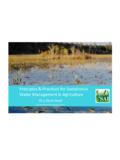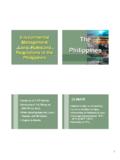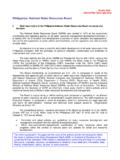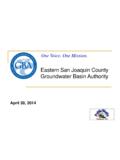Transcription of AUSTRALIA - OECD.org
1 AUSTRALIA WATER RESOURCES ALLOCATION OECD 2015 1 AUSTRALIA Overview and highlights In AUSTRALIA , water resources allocation regimes vary significantly depending on the particular state or territory, the environmental conditions and water management capacities. The Murray-Darling Basin is a good example of an extremely variable river system that is prone to periodic drought and flood events. Key characteristics of the prevailing allocation regime in the Murray-Darling Basin include: A Basin Plan1 that sets sustainable diversion limits and includes an environmental watering plan, a water quality and salinity management plan, and water quality targets, which influence environmental flows and guide water resources management.
2 The Plan is a statutory instrument that must be followed; Water ownership is independent of land ownership and water entitlements are granted to either individuals or collective bodies, such as water user associations; Entitlements are granted in perpetuity but conditional upon beneficial use; Annual water allocation regimes take into account climate variability by allocating less water to consumptive uses in drier years; A permanent water trading scheme is in place. Prices reflect changes in demand and supply of water entitlements related to climatic conditions, commodity markets, current and expected level of allocations (including unused allocations at the end of the water year) and changes in rules; For new entrants, access to surface water is limited to purchasing entitlements from existing owners.
3 Ground water use is conditional on the assessment of third party impacts, an environmental impact assessment (EIA) and existing users forgoing use; All abstraction charges are volumetric and they do not reflect water scarcity; The definition of exceptional circumstances varies across Basin jurisdictions. Stakeholders are involved in drafting legislation addressing exceptional circumstances. 1 Further information on the Basin Plan is available at: This country profile was compiled by the OECD Secretariat and reflects information available as of March 2015. Further information and analysis can be found in the publication: OECD (2015) Water Resources Allocation: Sharing Risks and Opportunities, OECD Studies on Water, OECD Publishing.
4 Country profiles for all of the 37 allocation regimes in 27 OECD and key partner countries surveyed for this project are available for download at: AUSTRALIA 2 WATER RESOURCES ALLOCATION OECD 2015 Legal and institutional setting for water allocation Institution Scale Main Responsibilities Murray-Darling Basin Authority (MDBA) Basin Policy and planning to ensure resources of the Basin are managed in an integrated and sustainable way New South Wales Office of Water Provincial/State/Regional Policy, planning and management including issuing entitlements Queensland Department of Natural Resources and Mines Provincial/State/Regional Policy, planning and management including issuing entitlements Victorian Department of Environment and Primary Industries Provincial/State/Regional Policy, planning and management including issuing entitlements South Australian Department of Environment, Water and Natural Resources Provincial/State/Regional Policy, planning and management including issuing entitlements West Australian Department of Water Provincial/State/Regional Policy.
5 Planning and management including issuing entitlements Tasmanian Department of Primary Industries, Parks, Water and Environment Provincial/State/Regional Policy, planning and management including issuing entitlements Northern Territory Department of Land Resource Management Provincial/State/Regional Policy, planning and management including issuing entitlements Australian Capital Territory Environment and sustainable Development Directorate Provincial/State/Regional Policy, planning and management including issuing entitlements Legal context for water allocation: Common Law. Legal definition of ownership of water resources: ground and surface water are defined as owned by the Crown. Tracking water scarcity Several mapping exercises have been done to identify areas where water scarcity is becoming a problem: CSIRO sustainable Yields Reports and Water Resource Assessment for the Great Artesian Basin.
6 AUSTRALIA WATER RESOURCES ALLOCATION OECD 2015 3 Allocation Regime Example: The Murray-Darling Basin Physical features of the water resource The water resource is defined by the catchment areas of the Murray and Darling rivers and their many tributaries. Comprising 23 main river valleys, the Basin extends over 1 million km2 of south-eastern AUSTRALIA . The Basin experiences considerable variation in annual inflow to its rivers and over the past 114 years, inflows have ranged from a high of 117 907 gigalitres (Gl) (in 1956) to a low around 6 740 Gl (in 2006).
7 Average annual inflows (including inter-basin transfers) are around 32 500 (Gl) with an average rainfall over the Basin around 530 618 Gl/ Hydrological connectivity between surface and ground water is variable across the Basin. Depending on the particular location, the flow is managed or controlled either fully, partially, or not at all. There is significant non-consumptive use for recreation ( fishing) and tourism. An estimated 430 000 people use the Basin for more than 5 million fishing trips per year. This use is generally non-consumptive, but is dependent on the degree of ecological health. Some Ramsar listed wetlands and riverine national parks are significant tourist destinations.
8 Also, more than 40 Indigenous nations across the Basin value water resources for cultural, social, environmental, spiritual and economic purposes. Lastly, inflows are augmented through the operation of the Snowy Mountains Hydro-electric scheme. Defining the available resource pool Are limits defined on consumptive use? Yes The Murray-Darling Basin Authority has produced a Basin Plan that serves as a comprehensive basin-wide regulatory instrument that sits above Basin state water resources plans to ensure resources of the Basin are managed in an integrated and sustainable way. It is a statutory instrument that must be followed. The allocation regimes are determined for each river catchment in the Basin by Basin states through their water resource planning process.
9 Each of the state water resource plans are required to be accredited under the Basin Plan. Are environmental-flows clearly defined? Yes The Basin Plan limits water use at environmentally sustainable levels by determining long-term sustainable diversion limits for both surface and groundwater resource. A key component of the Basin Plan is the environmental watering plan, which co-ordinates all environmental watering across the Basin. The Basin Plan also contains a water quality and salinity management plan and water quality targets which influence how environmental flows and the water resources are managed. Freshwater biodiversity is considered in watering requirements of various elements of the rivers and floodplains of the Basin, including flood-dependent vegetation, fish and water birds.
10 Terrestrial biodiversity is also addressed in the assessment of environmental watering requirements by considering key habitat components that support a range of terrestrial species, particularly those that rely on the structural components of floodplain vegetation for parts of their lifecycles. 29% 13% 42% 16% Surface water mean annual inflow/ recharge consumed per use: AgricultureDomestic/IndustrialEnvironmen tTransfer to the seaor another system6% 2% 40% 13% 39% Groundwater mean annual inflow/ recharge consumed per use: AgricultureDomesticEnvironmentRiver base flowStorageAUSTRALIA 4 WATER RESOURCES ALLOCATION OECD 2015 What is the status of resource pool?














